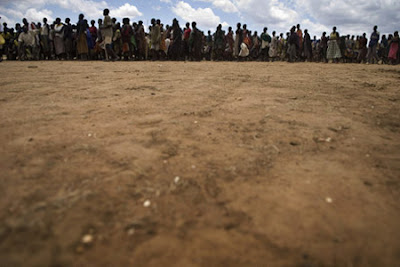
April 11, 2008
Only 67 of 121 Myanmar illegals survive journey in a sealed containerBANGKOK - IT WAS standing room only for 121 men and women packed into an airtight seafood container truck just 6m long and 2.2m wide.
The illegal migrants, fleeing low wages back home in Myanmar, had paid smugglers 5,000 baht (S$210) each to take them to jobs in the Thai resorts of Phuket and Phang Nga.
But, only 30 minutes into their journey, things went horribly wrong.
Gasping for air, the workers started screaming and pounding on the container walls. The driver turned on the air-conditioning, but only briefly.
An hour later, the screaming and banging stopped.
When the truck driver stopped to check, what he found made him flee.
Fifty-four people, 37 of them women, had suffocated and died. Another 67 were so deyhydrated and out of air that 20 had to be hospitalised.
'I thought everyone was going to die,' said a 30-year- old survivor now in police custody. 'I thought I was going to die. If the truck had driven for 30 minutes more, I would have died for sure.'
One female survivor told Thai television: 'No matter how many times we hit the container, the driver did not pay any attention.'
TV footage showed police lifting bodies out of the truck in Ranong province.
The dead - many wearing little more than T-shirts, shorts and flip-flops - were laid out on the floor at a storage facility of a local charity.
The truck driver was nowhere to be found.
'We believe this must be part of a smuggling racket which has to be tracked down,' said Ranong Police Colonel Kraithong Chanthongbai. 'The large number of illegals represents a very brazen act.'
More than a million people from Myanmar are estimated to be working illegally in Thai factories and restaurants, at petrol pumps and as domestic helpers or crew on fishing trawlers.They have continued to stream out since the unrest in August, when protests that included Buddhist monks snowballed into anti-government demonstrations.
Many have fled Myanmar by walking across the border with Thailand although it is littered with landmines.
Others have attempted a long sea trip, usually made on flimsy boats without adequate supplies.
Still more turn to smugglers to take them across.
The results are often grim.
In January, seven illegal migrants were found dead, apparently having drowned in a Thai lake while making the illegal crossing.
Last December, at least 22 died when their boat sank.
REUTERS, AGENCE FRANCE-PRESSE
It's sad to read a tragedy like this. The heartless driver killed the 67 Myanmar people because of his disregard for human lives. There are so many teaching points from this article related to the topic on development. First, when the country is poorly governed (weak leadership), the people suffer because of unemployment or low pay and also political instabiliy (war and conflict). In search of better life, the people will move out to other places legally or illegally. The legal migration will be called "brain drain". The illegal one is called the "refugee" problem. This also reinforces what I told you in class about why international cooperation is important. The DCs will try to help the LDCs if not when the people start moving out as refugees to the their countries, it'll pose other social problems to them. Of course, it's every country' s duty to help one another to improve the standard of living in the world but we'll not forget that there is political motive too.
Don't you think we are blessed to be in Singapore? Can you see the work of good governance?




















